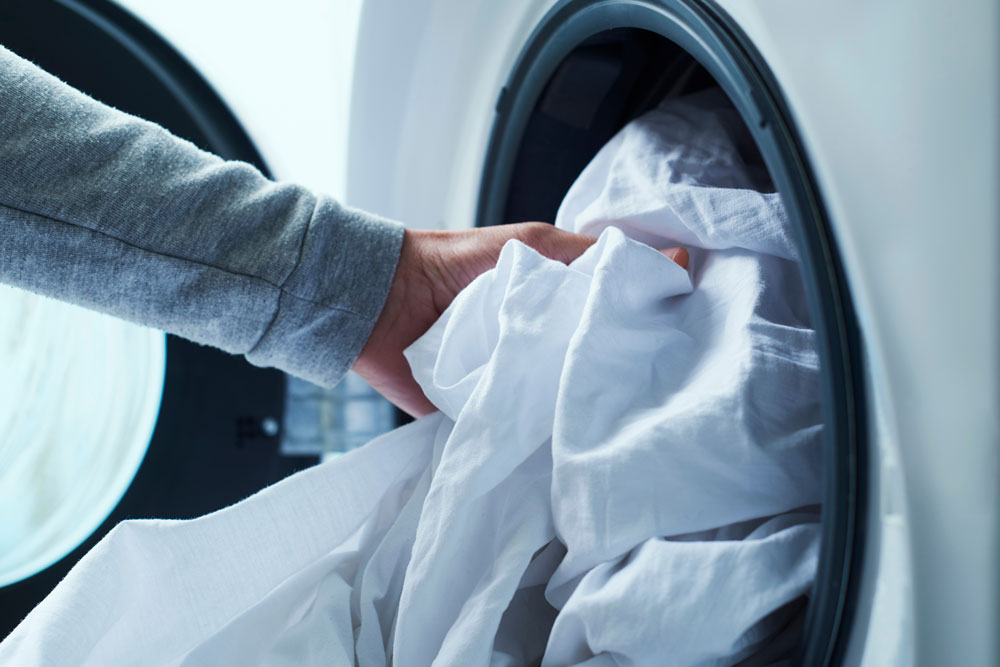Can You Wash Mould Out of Clothes?
 CONTENTS
CONTENTS
- What causes mould on clothes?
- How to remove mould from fabric
- You should always bring in professionals for mould remediation
- How to prevent mould on your clothes
- Get in touch
If you spot mould growing on your clothes, your first instinct will probably be to put it in the wash. But mould is not like other stains - it is very difficult to remove, and if not gotten rid of, could spread to your other clothes or washing machine.
You must bring in professional mould cleaners as soon as you spot mould growing anywhere in your home as it can cause serious health problems.
Here at ICE Cleaning, we offer our mould cleaning services nationwide. Our technicians have been accredited by Dewpoint Professional, and have the specialist equipment and cleaning agents to thoroughly and quickly remove all traces of mould from your home.
Keep reading to find out what causes mould to grow on clothes and how to remove it from them.
What causes mould on clothes?
Mould thrives in damp, humid environments. Damp clothes left in the washing machine after the wash cycle has finished or put in wardrobes while still wet can offer just the right conditions for mould to grow.
A poorly ventilated and organised wardrobe also invites trouble as stagnant air promotes humidity build-up. If your closet is not getting enough fresh air circulation, those dark corners could become hotspots for unwanted fungal guests. Mould can grow in the washing machine, as well, which can cause mould on clothes after washing.
Organic fabric like cotton are particularly vulnerable to mould growth as it feeds off organic material. Fabric is porous, too, so they hold onto moisture well.
If your home struggles with high humidity levels due to things like inadequate heating during winter months or excessive condensation problems, you should expect more challenges with preventing mould growth on clothes.
You can find out more about what causes mould to grow in washing machines in this blog and in wardrobes in this blog.
How to remove mould from fabric
Mould stains are notoriously difficult to remove, but all of the mould must be eliminated or it can soon grow back. Its deep penetration into fabric pores makes it quite challenging to eradicate as some of it can evade treatment and continue to grow.
You might be tempted to give DIY mould removal methods a try, however, they can threaten your health by bringing you in close contact with the mould. Using bleach or a mould remover on fabric, for example, can cause more harm than good.
They can lead not only to damage and discolouration of your garments, but also pose risks for your health. Excessive use of bleach, for example, can cause respiratory issues and skin irritation.
You should always bring in professionals for mould remediation
Mould removal is not a job to tackle alone. Professionals like those at ICE Cleaning have the expertise and tools to handle it safely, including personal protective equipment (PPE) so they don't inhale, ingest, or touch the mould. Exposure can trigger health problems including allergic reactions and respiratory infections.
They will also have experience with many safe and effective techniques for eradicating both surface-level infestations and deeply rooted colonies. They will completely eliminate the mould without causing damage to your property.
Our technicians can even pinpoint the specific cause of the mould and advise on how best to prevent it returning to your home.
How to prevent mould on your clothes
There are plenty of practical steps you can take to protect your clothing. The key is understanding that damp environments and lack of air circulation provide ideal conditions for mould.
Firstly, make sure all garments are completely dry before storing them away. Even the slightest moisture can invite unwanted mould growth.
The way you store your clothes also matters significantly in preventing mould formation. For instance, overcrowded wardrobes hinder airflow which encourages dampness and subsequently leads to mould development.
To avoid this scenario, try not to pack too many items into one space and make sure there is space around them for air to circulate. Consider using wardrobe dehumidifiers or silica gel packs, as well, which absorb excess humidity and keep your storage spaces dry.
Lastly, air out your wardrobes and cupboards regularly. If possible, let sunlight reach inside the spaces where you store your clothes as UV rays kill mould.
Get in touch
We offer a lifetime guarantee* with all of our mould removal services so if the mould comes back we will get rid of it for free. Our technicians are available nationwide, 24/7, 365 days a year. In an emergency, they can be on site within several hours.
Contact our team today on 0208 066 0360 or enquiries@icecleaning.co.uk for a free site survey and no-obligation quote for mould remediation.
*subject to advisories.

Speak with me today,
I’m here to help
By asking you a few questions either via phone or email I can immediately provide a realistic estimation of the cost.
You’re in good company. We’ve cleaned for the following commercial clients… View all

Why choose us?
- Cater to a wide variety of cleaning situations
- Nationwide coverage, available 24/7
- Cater to commercial and domestic clients
- Free survey provided prior to quotation
- Emergency response team
- Offer a bespoke service designed to suit all your needs
- All technicians hold professional health and safety qualifications, including BICSc, IOSH, Dewpoint Professional & Safe Contractor
We’re fully accredited
We place best practise, professional expertise and health and safety at the core of our business. We’re fully compliant with all legal obligations. You can view a list of our accreditations below, or visit our Health & Safety page for more information.











-RGB-small.1707319151.jpg)




















